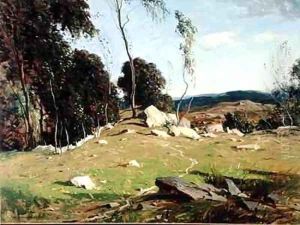George M. Bruestle Paintings
George M. Bruestle was an American painter known for his impressionist landscapes that often depicted the rural New England countryside. Born on June 25, 1872, in New York City, Bruestle developed an interest in art at an early age. He initially studied at the Art Students League of New York, a prestigious institution where many American artists received their education. Later, he furthered his studies in Paris at the Académie Julian, a popular destination for American artists wanting to immerse themselves in the European art scene of the late 19th century.
Bruestle's style was largely influenced by the impressionist movement, which emphasized the effects of light and color, often with a focus on capturing fleeting moments in time. After returning from Europe, Bruestle settled in Connecticut, where he found great inspiration in the landscape. He became particularly associated with the Lyme Art Colony, an influential group of artists who worked in and around the town of Old Lyme, Connecticut. The colony was part of the larger American Impressionist movement, and Bruestle's work from this period reflects the colony's emphasis on plein-air painting, a technique involving painting outdoors to capture the nuances of natural light.
Throughout his career, Bruestle exhibited his work widely, including at the National Academy of Design and the Pennsylvania Academy of the Fine Arts. He was also a member of the Salmagundi Club, a New York City institution that was central to the American art scene. Bruestle's landscapes are characterized by their vibrant color palette, textural brushwork, and serene depictions of the rural American landscape, often featuring rolling hills, farmhouses, and autumnal scenes.
George M. Bruestle passed away on September 25, 1939. His paintings remain in various collections and continue to be appreciated for their contribution to American Impressionism. His work is a testament to the beauty of the New England countryside and reflects a period in American art when artists were exploring new ways of seeing and depicting the world around them.
